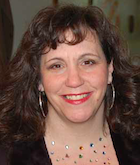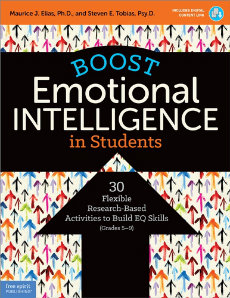30 Flexible Activities to Build SEL and EQ Skills
Boost Emotional Intelligence in Students: 30 Flexible Research-Based Activities to Build EQ Skills (Grades 5-9)
By Maurice J. Elias, PhD, and Steven E. Tobias PsyD
(Free Spirit Publishing, 2018 – Learn more)

The Lowdown on SEL and EQ
If you are looking for lesson plans to help you boost social and emotional learning (SEL) in your middle, junior high, or high school, this book will be a great addition to your toolkit. SEL is a hot topic in education circles today and it should be.

The authors state that the purpose of the book is to “make your EQ efforts more structured, intentional, and successful – as well as easier” (p. 1). That the book specifically targets teaching strategies for middle grade students is refreshing. Anyone who has taught this age can relate to what Dr. Norris Haynes says in the introduction,
These are years of intense change and growth. And the challenges and dilemmas faced by students this age are more difficult and complex than those faced by younger children” (p. x).
Grades four through nine can be angsty and full of confusion and uncomfortable self-consciousness. Students need us to help them develop tools to navigate adolescence and to carry them into happy and productive adulthoods.
The Big Picture Skills
Before delving into practical lessons, strategies, and other ideas, the authors lay out the essential categories of EQ skills and the implications neurological research about the adolescent brain has for them. The big picture skills are:
1. Self-awareness and self-management;
2. Social awareness and relationship skills; and
3. Responsible decision-making and problem-solving.
Contrast these needed skills with the fact that brain research indicates the adolescent brain “is notable for its advanced development in emotions without corresponding developmental advances in self-control” (p. 5). Thus, as many teachers of students this age know, you have the recipe for a perfect storm!
This disjointed brain development phase, in part, is why teachers must find the time to integrate SEL lessons into the school day. Again, our students are counting on us, and not letting them down is not only good for them but for society as a whole.
The Lessons
The authors have developed a series of 30 lessons that help build on the 15 EQ needs – organized into three modules corresponding to the three big-picture EQ categories noted above. Within each module, five skills are explored with two lesson plans for each. For example, in Module 1: Self-Awareness and Self-Management, the skills included are:
- Knowing Your EQ Strengths and Challenges
- Understanding Your Values and Being Your Best Self
- Thinking and Talking about Feelings
- Recognizing Negative Self-Talk and Practicing Positive Self-Talk
- Achieving and Maintaining Self-Control
The lessons for this module and the two that follow are extremely user-friendly and all share the same format. Each begins with an overview of the what’s and why’s of the lesson and a list of what needs to be prepared in advance.
The lesson itself calls for teachers and students to review previous lessons, conduct a “sharing circle” discussion activity designed to get students ready for the work to come, a “skill introduction” which is the heart of the learning, a reflection activity, and a suggested homework follow-up. All of the materials needed are found after the lesson plan, in ready-to-photocopy format.
Each lesson can be used as is, but all are easy to modify to meet the specific needs of your students. I cannot overstate how well-organized this book is and the potential it has to make SEL lessons practical and productive for busy teachers. This is a great book, folks. I can’t wait to teach the lessons!
Watch a free webinar with the authors here.
Rita Platt (@ritaplatt) is a National Board Certified teacher with master’s degrees in reading, library, and leadership. Her experience includes teaching learners in remote Alaskan villages, inner cities, and rural communities. Slated to become her school’s principal Fall 2018, she currently is a teacher-librarian, teaches graduate courses for the Professional Development Institute, writes for We Teach We Learn, and blogs at Heart of the School for MiddleWeb.



































